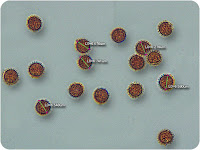Last summer a small area of Pembrey Forest caught fire reducing many of the Corsican Pine trees to charred stumps. Though a tragedy for most of the forest wildlife it was a boost for Fungi as they have sprung up everywhere - some of the species having been rarely recorded in Wales.
Also growing on the burnt gorse was Schizophyllum commune (Split Gill Fungus). This is a real survivor as it can be found growing on those big black haylage rolls in farmer's fields, on beech logs in Waun Las and on burnt Gorse in Pembrey Forest. The Cockroach of the fungus world. Perhaps in the weeks after Armageddon when the smoke and the dust begins to clear, there will be S. commune making a living off the charred and twisted remains of Carmarthenshire's ancient woodland!
With free gills and pink spores, this had Pluteus cervinus (Deer Shield) written all over it but later it was noticed that the gill edges were definitely black. It turns out that this was Pluteus atromarginatus (Black edge Shield) -which favours burnt conifer wood - and this was later confimed by the presence of "horns" on the cystidia. Although not rare it has very few Welsh records.
Sharing the same bed as Pluteus atromarginatus, was Gymnopilus junonius (Splendid rustgill) and plenty of it. By all accounts it is not a lover of conifer wood but it looks so distinctive that I am sure that this is what it was - although would be happy to be corrected.
Another visitor to our charcoal ghost forest was the Bonfire Scalycap, Pholiota highlandensis, identified on Facebook by Geoffrey Kibby. This again is a species with very few Welsh records and will be another welcome addition to our end of year list. I was surprised that this was a Pholiota, as they have the common name Scalycaps, whereas as we can see from the photo alongside - these mushrooms look more like the Mitchell brothers. Having seen a few "true" Scalycaps I think there would be no contest in a beauty competition.
Not technically a fungus, indeed not even a fungus at all this Woolf's milk slime mould also came along to enjoy the party. What made it interesting however was that the individual fruit bodies don't usually grow this large or indeed overall to be so prolific - perhaps all the free food. There are a couple of types of these Woolf's milk slime moulds but the spores and their pinkish brown colour identify this as Lycogala terrestre - the more common one!













Cracking finds
ReplyDeleteAs Philip said on Facebook it will have some interesting species over the months
Did you also see the ear lash on the ground it was everywhere along the burnt grass
Think I will pop down again soon it’s rained a lot lately
No I missed the eyelash fungi, have to stay longer next time. Must say was impressed with the amount I did see. -Perhaps we can ask permission to burn down Troserch Woods and see what happens after??
DeleteAlso the laughing gyms I’ve only seen on conifer there
ReplyDelete